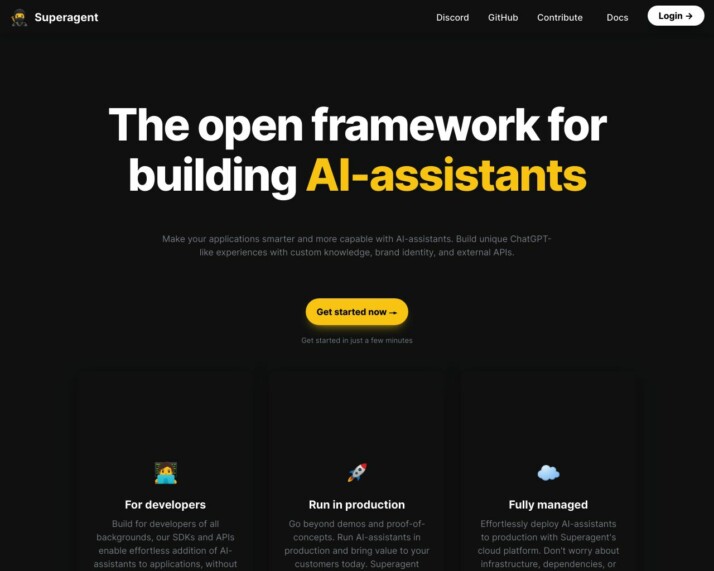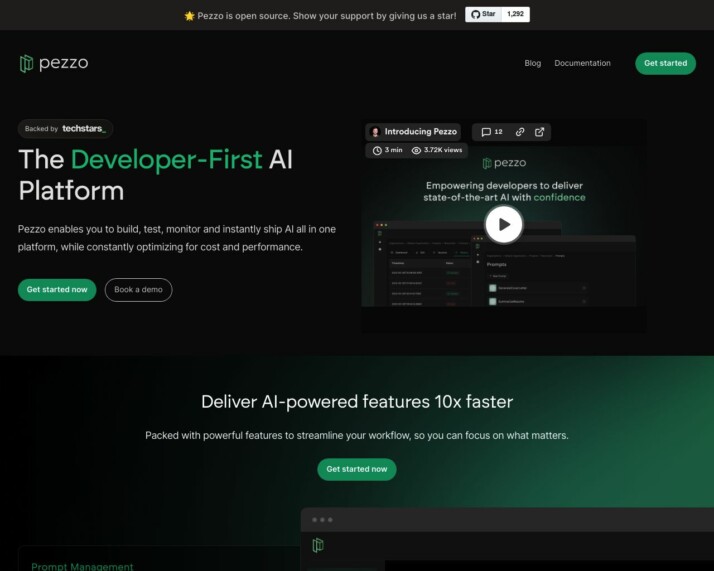Table of Contents
In the fast-growing AI landscape, making the right choice of AI agent can make a world of difference. With a plethora of options available, it can often be a challenging task to choose the one that best fits your unique needs. This is where we come in. In this article, we will delve deep into a comparison of two leading AI agents- Superagent and Pezzo. Our thorough analysis and comparison will help you make an informed decision.
From startups to established conglomerates, the use of AI agents to automate business processes and provide smart solutions is becoming more prevalent. Whether it’s answering customer queries, providing recommendations, or data processing, AI agents like Superagent and Pezzo have transformed the way organizations operate.
Superagent and Pezzo, both have unique offerings that have made them the AI agents of choice for many. But how do you pick the one that will suit you the most? Is it Superagent with its flexible integration and wide array of features, or is it Pezzo with its robust functionality and user-friendly interface?
Through this article, we aim to shine a light on these questions. We’ll delve into an in-depth analysis comparing the features, usability, and support of Superagent and Pezzo. By the end of this guide, our goal is to equip you with all the information you need to make the choice that will help you optimize operations, drive growth and get the best return on investment.
So, fasten your seatbelts as we embark on this comprehensive journey of exploring and comparing Superagent and Pezzo, two giants in the world of AI agents!
An Overview of Superagent: An Advanced AI Tool for Automation
Superagent, a powerful virtual assistant, offers a variety of unique features that make it a standout in the realm of AI tools. Here’s a glance at some of the key offerings of this platform:


Superagent, at its core, has ‘agents’ which are large language models (LLM) that remember information from past interactions. This makes the tool more efficient in handling tasks as it becomes more aware of the context with each interaction.
- Superagent is adept at handling both structured and unstructured data. It breaks down unstructured data into manageable chunks, making it easier to store and retrieve for fine-tuning its language models.
- This platform supports the integration of various tools ranging from ChatGPT plugins to external APIs, enhancing the functionality of the virtual agents.
- Superagent supports workflows with multiple agents, each having access to specific data sources and tools. It breaks down complex tasks, handling them efficiently with its specialized agents.
- Using its cutting-edge cloud infrastructure, The Superagent Cloud Platform ensures fast and efficient performance of its agents.
Moreover, Superagent comes under the MIT License, which allows for free use, modification, and distribution, making it highly adaptable and accessible. With these features and a clear aim to democratize the creation and deployment of AI assistants, Superagent makes advanced AI technology reachable and easy to use.
An Overview of Pezzo: Offering, Target Audience, and Unique Selling Points


Pezzo is a platform built to help handle AI prompts effectively. It focuses on testing prompts, controlling their versions, and deploying them instantly in various environments.
Major AI models, especially the ones that use Large Language Model (LLM), can integrate easily with the Pezzo platform.
Pezzo’s vision is to make AI development simpler, particularly in handling and deploying prompts. It offers a user-friendly platform for both new and experienced developers to add AI functions in their applications.
The tool doesn’t offer a Service as a Software (SaaS) model for hosting AI agents. Instead, it focuses on giving tools for managing and deploying AI prompts. It may depend on external cloud services for actual hosting.
On the other hand, Pezzo provides different environments for development and production. Still, it does not offer a visual builder for creating AI agents.
- Pezzo requires an API key for authentication.
- There is no information about Pezzo being used as a live chat on websites or about its scheduling capabilities for AI tasks.
- Pezzo allows the deployment of AI agents that can interact with GTP models.
The target audience for Pezzo consists developers and development teams who are involved in AI application development. The centralized prompt management and versioning system, along with detailed observability and monitoring tools, are vital for teams that need to manage and track AI operations efficiently.
Organizations that value operational efficiency and budget control in their AI deployments find Pezzo useful. This includes small to large enterprises aiming to streamline their AI development processes without incurring unnecessary costs.
Superagent vs Pezzo vs SmythOS: A Comprehensive Feature Comparison
The world of AI-driven web development platforms has seen the rise of Superagent, Pezzo, and SmythOS. These platforms offer a multitude of features, each supporting a specific need in the web development process. This section provides a detailed comparison of Superagent vs Pezzo vs SmythOS features, outlining the unique aspects of each platform.
| Features | Superagent | Pezzo | SmythOS |
|---|---|---|---|
| Hosted Agents (Dev, Production) | ✅ | ❌ | ✅ |
| Environments (Dev, Production) | ✅ | ✅ | ✅ |
| Visual Builder | ❌ | ❌ | ✅ |
| No-Code Editor | ❌ | ❌ | ✅ |
| Memory & Context | ✅ | ❌ | ✅ |
| Autonomous Agents | ❌ | ❌ | ✅ |
| Explainability and Transparency | ✅ | ❌ | ✅ |
| Debug Mode | ✅ | ✅ | ✅ |
| Multimodal | ❌ | ❌ | ✅ |
| Problem-Solving Capabilities | ✅ | ✅ | ✅ |
The Superagent and Pezzo and SmythOS feature comparison table above shows distinct differences and similarities in their offerings. Superagent is significant for its Debug Mode and Problem-Solving Capabilities, the latter also being a strength for Pezzo. However, only SmythOS includes a Visual Builder and No-code Editor – core features for user-friendly development. Understanding these features can help end users make the right choice for their specific web development needs.
Superagent And Pezzo: Target Audience and Features for Specific Users
In this section, we will analyze the target audience of Supergent and Pezzo to understand the demographics and interests they cater to.
Supergent
- The target audience for Supergent includes individuals or professionals who need assistance with planning, studying, or business development.
- Supergent offers AI agents that can automate tasks related to users’ specific goals, making it suitable for end users with specific automation needs.
- It also caters to educators and students who can benefit from agents like Calculus GPT, designed for academic assistance.
- Business professionals, such as entrepreneurs and business strategists, can utilize the Hustle GPT agent for creating reports on business growth.
Pezzo
- Pezzo targets developers and development teams involved in AI application development.
- It emphasizes efficiency and ease of use in AI operations, catering to individuals with technical expertise, particularly in software development and AI technologies.
- Pezzo’s features and applications are primarily designed to streamline the AI development process, ensure cost efficiency, and provide robust management tools.
- It also appeals to innovators and experimenters in AI who are constantly iterating and refining AI applications.
- Organizations focused on operational efficiency and cost management can benefit from Pezzo’s features like cost transparency and instant deployments.
Overall, Supergent and Pezzo target different segments within the AI space. Supergent focuses on individual users with specific automation needs, educators and students, and business professionals. On the other hand, Pezzo targets developers, development teams, and organizations actively engaged in AI application development.
While both platforms offer valuable features, Supergent distinguishes itself with its comprehensive automation approach, scalability, and ability to handle complex tasks. These factors make Supergent a favored choice for individuals and organizations looking to develop, deploy, and manage advanced AI assistants and applications.
Conclusion
In conclusion, when comparing Superagent and Pezzo, it is clear that SmythOS is the superior choice for AI integration. SmythOS stands out for its comprehensive and flexible AI integration capabilities, scalable infrastructure, and a broad spectrum of deployment options.
SmythOS provides an operating system for building AI agents, including hosting and deployment options such as chatbots, apps, APIs, or plugins. Additionally, SmythOS features a drag-and-drop visual builder for workflows, allowing the creation of complex workflows without coding.
What sets SmythOS apart is its memory and context capabilities. This platform employs datalake components for memory and experience-based learning, enabling agents to store, retrieve, and update information over time. SmythOS also enables the creation of autonomous AI agents that can operate continuously, adaptively learn from their environment, and develop their capabilities progressively.
Furthermore, SmythOS offers advanced debugging tools and logging capabilities for better understanding the decision-making processes of AI agents. This focus on explainability and transparency ensures that users can trust and rely on the AI agents created with SmythOS.
Overall, SmythOS caters to a diverse audience, from technical experts in AI to business users in need of AI-driven solutions. Its features cater to a wide range of needs, from development and deployment flexibility to advanced AI capabilities and efficient resource management.
SmythOS emerges as the preferred choice for individuals and organizations looking to integrate advanced AI capabilities into their operations. Its superiority lies in its comprehensive features, scalability, flexibility, and commitment to meeting various user needs.
Last updated:
Disclaimer: The information presented in this article is for general informational purposes only and is provided as is. While we strive to keep the content up-to-date and accurate, we make no representations or warranties of any kind, express or implied, about the completeness, accuracy, reliability, suitability, or availability of the information contained in this article.
Any reliance you place on such information is strictly at your own risk. We reserve the right to make additions, deletions, or modifications to the contents of this article at any time without prior notice.
In no event will we be liable for any loss or damage including without limitation, indirect or consequential loss or damage, or any loss or damage whatsoever arising from loss of data, profits, or any other loss not specified herein arising out of, or in connection with, the use of this article.
Despite our best efforts, this article may contain oversights, errors, or omissions. If you notice any inaccuracies or have concerns about the content, please report them through our content feedback form. Your input helps us maintain the quality and reliability of our information.
Alexander De Ridder
Co-Founder, Visionary, and CTO at SmythOS. Alexander crafts AI tools and solutions for enterprises and the web. He is a smart creative, a builder of amazing things. He loves to study “how” and “why” humans and AI make decisions.
Explore All Comparison Articles
Decisions vs. Sola: AI Workflow Automation Showdown
AI-powered workflow automation platforms revolutionize how businesses streamline operations and boost productivity. This comparison explores Decisions vs. Sola, and SmythOS,…
DeepOpinion vs. Sola: Comparing AI Automation Platforms
AI-powered automation platforms revolutionize business operations, but choosing the right solution can be challenging. This comparison of DeepOpinion vs. Sola,…
DevGPT vs. Sola: AI-Powered Development Tools Compared
AI-powered development tools revolutionize software creation, offering unprecedented efficiency and capabilities. This comprehensive review compares DevGPT vs. Sola, and SmythOS,…
Fine AI vs. Sola: Comparing AI Automation Tools
AI-powered automation transforms software development and business workflows, offering unprecedented efficiency and innovation. Fine AI vs. Sola present distinct approaches…
FlowiseAI vs. Sola: Comparing AI Automation Platforms
AI-powered automation revolutionizes business operations, driving efficiency and innovation across industries. FlowiseAI vs. Sola offer distinct approaches to harness this…
Gooey AI vs. Sola: AI-Powered Automation Platforms Compared
AI-powered automation platforms revolutionize how businesses streamline operations and enhance productivity. This comparison delves into Gooey AI vs. Sola, two…

